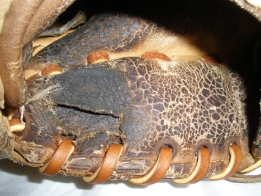This is my 40 year old Spalding Glove. It has definitely seen better days. I’m on a bit of a journey to bring it back to some of it’s former glory, even though it is not now my main glove.
So far I have re-laced it. This cost about $25 for the laces and lacing needle and took probably about 2 hours. This has improved the exterior look and added some of the strength of the glove.
If you look carefully you will see that the inner leather, where the palm of the left hand connects, is seriously damaged. Based on my research this is due to sweat on leather – they are not best friends.
There is no treatment for this situation. Once the damage has been done, it cannot be undone. The only option is to open the glove up and replace the hard, scratchy, torn leather. Not a task for a novice glove repairer and so is not something I am ready to try – just yet.
For most of the time I have used the glove I have worn a batting glove on that hand, largely as an additional layer of leather to reduce the damage to the joint at the base of the index finger on those occasions I don’t get the ball exactly into the pocket (unfortunately, not a rare occurrence) and because the glove always felt a little loose on my hand. This strategy probably extended the life of the glove by several years.
What I only found out in the last few weeks is that I should have been using a series of batting gloves throughout each game rather than just a single inner glove. Particularly on the hot days the inner glove will eventually become saturated with sweat and then the outer glove becomes exposed to that sweat and the damage starts. Replacement batting gloves are a lot cheaper than a new fielding mitt and take a lot less time to break in.
What else can you do to reduce this damage?
Apart from changing batting gloves, there are 2 other strategies to minimise this damage. First apply leather conditioner periodically to the leather surface. One of the leather care products I keep hearing about, particularly in the baseball context, is Lexol. There is both a cleaner and a conditioner that are recommended by a few leather outlets in the USA. It’s hard to track down in Australia, but I’ve seen it from some Car Care outlets, but usually in large containers, which is more than a baseball team might require for 10 years. I have also seen recommendations for Petroleum Jelly for conditioning the leather, but I would NOT try this just before a game, you might be accused of ball tampering.
The second option is to make sure the glove is dry before storing it in your baseball bag to fester. Don’t dry it in the sun or using any artificial heat source. A couple of hours somewhere well ventilated should do the trick. This is equally important after playing on a wet and miserable day as it is after playing on a hot one.
If you want to clean your glove and don’t have a specific product, you can use a mild soap (but never a detergent) and water. Take care not to overload the leather with the water. Then make sure the leather is dry before applying some sort of conditioner.
Summary
So the main points are:
- Wear a batting glove inside your fielding glove and change it as soon as it get wet. NB: You can’t use a batting glove if you’re the pitcher. Your limited to the other strategies.
-
Dry the glove any time it gets wet (rain, cleaning or sweat) before putting it away.
-
Condition the leather periodically (end of every season is probably the minimum).
By the way, if you would like to talk about re-lacing your glove send me an email. If enough people are interested, I would source a reasonable supply of Lexol and condition all the gloves. It would probably work out between $4 and $8 per glove, depending on numbers.
